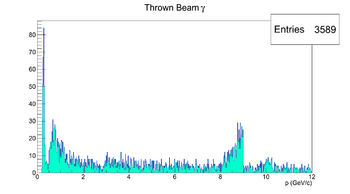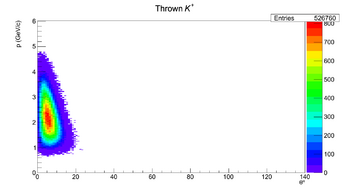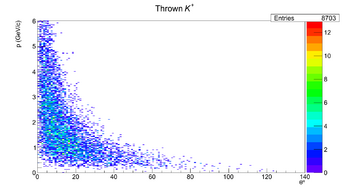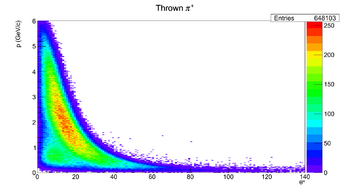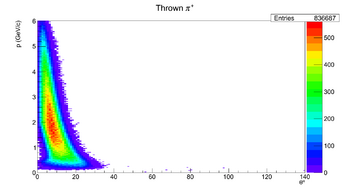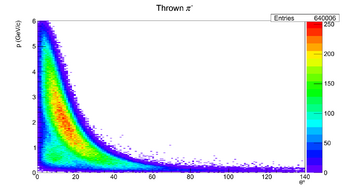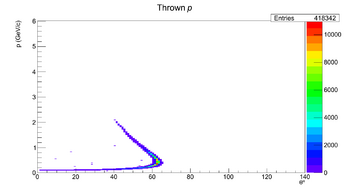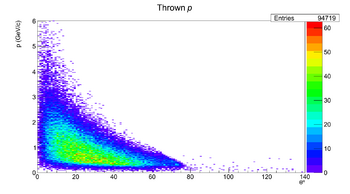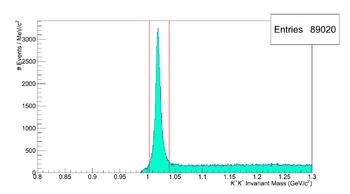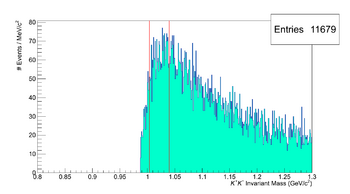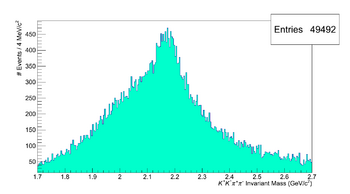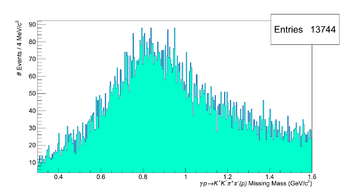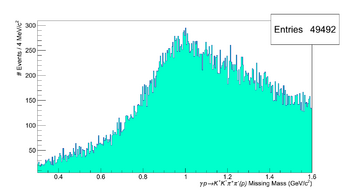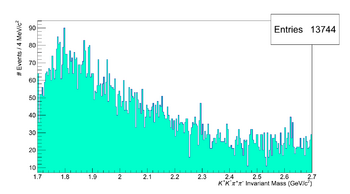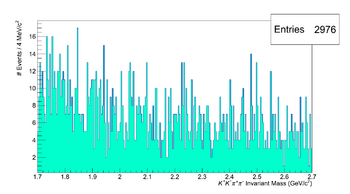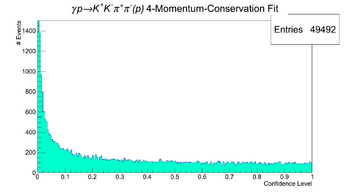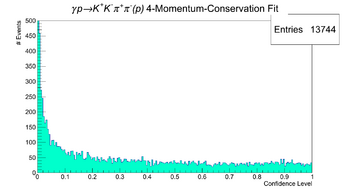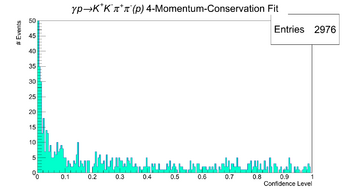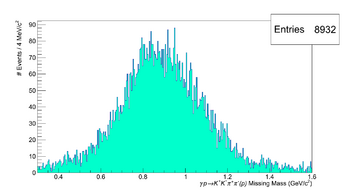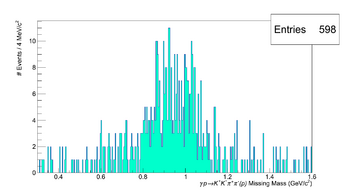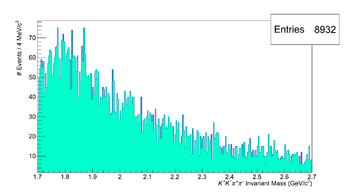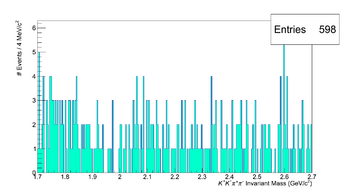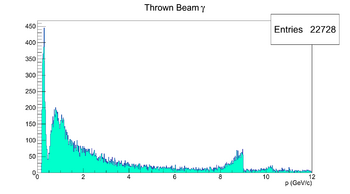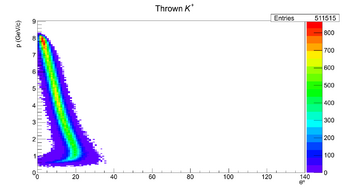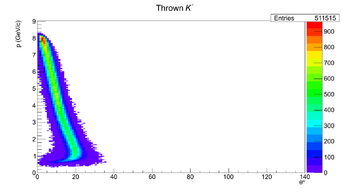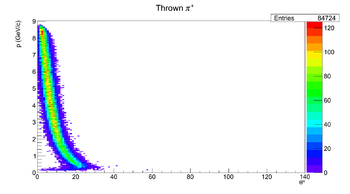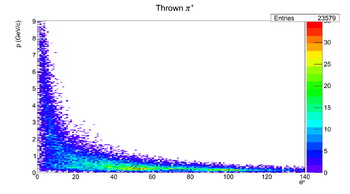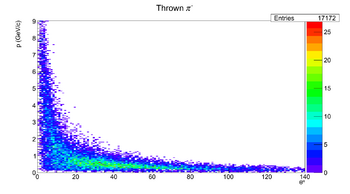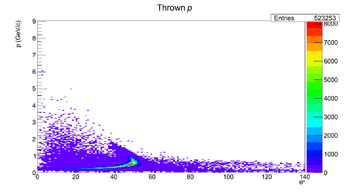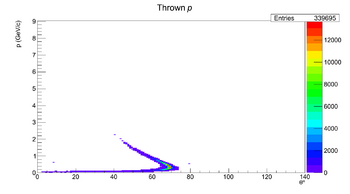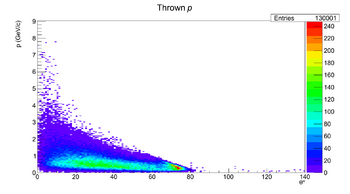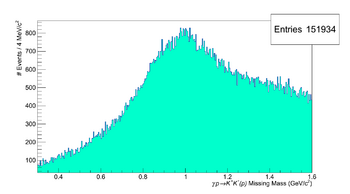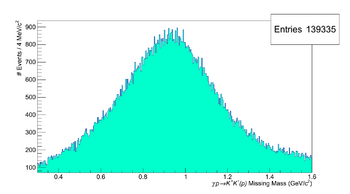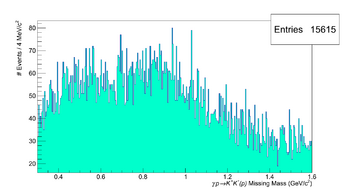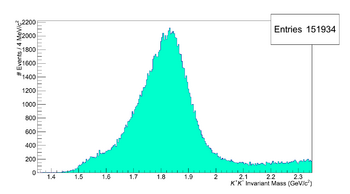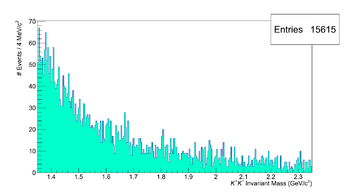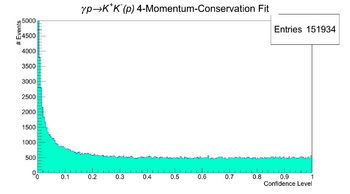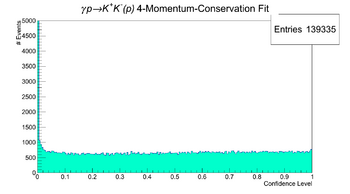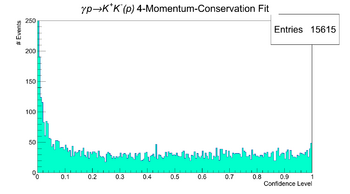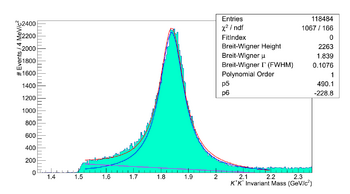Mattione Update 07092012
From GlueXWiki
Contents
Y(2175) Study Overview
Reaction
- γ p → Y(2175), p
- Y(2175) → π+, π-, φ
- φ → K+, K-
- Y(2175) → π+, π-, φ
- Final State: p, π+, π-, K+, K-
- Events generated using genr8 with: 9 GeV Photons, ΓY(2175) = 61 MeV/c2, t-slope = 5.0, 50.0 < Vertex-Z (cm) < 80.0
Background Channel
- γ p → f1(1285), p
- f1(1285) → π+, π-, π+, π-
- NOTE: had to trick genr8 by having the f1(1285) decay to η, η, and then each decaying to π+, π-
- Final State: p, π+, π-, π+, π-
- Events generated using genr8 with: 9 GeV Photons, Γf1(1285) = 24 MeV/c2, t-slope = 5.0, 50.0 < Vertex-Z (cm) < 80.0
bggen
- Generated entire photon energy region
Analysis Overview
- For each q = +/- particle in the reaction, all detected q = +/- tracks are tested as to whether or not they are that particle
- e.g. If a q = + track has PID FOM > 1% for both the π+ & K+: allow both combinations (DO NOT take the best FOM as true!)
- The analysis (cuts/histing/kinfits) is then performed on each possible track combination (events are only cut if every one of their track combinations is cut):
- Required reconstruction of >= 2 q+ Tracks, >= 2 q- Tracks (proton is treated as missing)
- Required 45.0 < Track-Vertex-Z (cm) < 85.0
- Require the combined FOM for PID (π+, π-, K+, K-) be > 1%
- Place very loose cuts on the φ invariant mass (0.8 - 1.3) and p missing mass (0.3 - 1.6): reduces # of bogus track combinations to save time / cleanup histograms
- Phi mass cut: 1.004 < K+K- Invariant Mass (GeV/c2) < 1.04
- Kinematic Fit: 4-momentum conservation: p missing mass
- Require that the confidence level from the kinematic fit be > 1%
Y(2175) Study Analysis
- First Analysis Step:
- Require reconstruction of >= 2 q+ Tracks, >= 2 q- Tracks (proton is treated as missing)
Thrown Track Parameters
- Thrown Track Parameters
- NOTE: Counts in bggen Photon plot are not self consistent with other bggen plot counts (had to cobble it together).
| Track | Y(2175) | f1(1285) | bggen |
|---|---|---|---|
| γ | Spike at E = 9.0 GeV | Spike at E = 9.0 GeV | |
| K+ | NA | ||
| K- | NA | ||
| π+ | |||
| π- | |||
| p |
Initial Mass Peaks
- Next Analysis Steps:
- Required 45.0 < Track-Vertex-Z (cm) < 85.0
- Require the combined FOM for PID (π+, π-, K+, K-) be > 1%
- Initial Mass Peaks
- Note: The peak in the f1(1285) φ-mass plot is due to my forcing the f1(1285) to decay to ηη, with each η decaying to π+π-.
| Mass Peak | Y(2175) | f1(1285) | bggen |
|---|---|---|---|
| φ | |||
| p | |||
| Y(2175) |
Kinematic Fitting
- Next Analysis Steps:
- Place very loose cuts on the φ invariant mass (0.8 - 1.3) and p missing mass (0.3 - 1.6): reduces # of bogus track combinations to save time / cleanup histograms
- Phi mass cut: 1.004 < K+K- Invariant Mass (GeV/c2) < 1.04
- Kinematic Fit: 4-momentum conservation: p missing mass
- Confidence Level
- NOTE: The pulls had sigmas of ~1.5 - 1.6, and the p_z means were +/- 0.2 (other means were 0). This is possibly due to my having an incorrect variance for the photon energy, and combinatoric background seeping into the distributions.
- NOTE: the spike at zero for these distributions is way above the top of the plots.
| Fit Constraint | Y(2175) | f1(1285) | bggen |
|---|---|---|---|
| (p) |
Final Mass Peaks
- Final Analysis Step:
- Require that the confidence level from the kinematic fit be > 1%
- Final Mass Peaks
- NOTE: proton peak uses pre-kinfit track momentum, Y(2175) peak uses post-kinfit track momentum
| Mass Peak | Y(2175) | f1(1285) | bggen |
|---|---|---|---|
| p | |||
| Y(2175) |
Y(2175) Study Statistics
- % of events & track combinations that survive cuts and are near the signal peak.
- NOTE: Final column is "rough" because I assumed that the track combination / event ratio is mass-independent (I just multiplied columns 2 & 4)
| Reaction | # Generated Events | % Events Survive Cuts | # Surviving Track Combos / Surviving Event | % Surviving Track Combos within +/- 2Γ (84.4%) of Y(2175) mass peak | Rough % Generated Events within +/- 2Γ (84.4%) of Y(2175) mass peak |
|---|---|---|---|---|---|
| Y(2175) | 323196 | 7.4% | 1.17 | 73.8% | 5.5% |
| f1(1285) | 503125 | 1.6% | 1.13 | 40.4% | 0.65% |
| bggen | 1047972 | 0.044% | 1.31 | 27.8% | 0.012% |
φ3(1850) Study Overview
Reaction
- γ p → φ3(1850), p
- φ3(1850) → K+, K-
- Final State: p, K+, K-
- Events generated using genr8 with: 9 GeV Photons, Γφ3(1850) = 87 MeV/c2, t-slope = 5.0, 50.0 < Vertex-Z (cm) < 80.0
Background Channel
- γ p → f0(980), p
- f0(980) → π+, π-
- Final State: p, π+, π-
- Events generated using genr8 with: 9 GeV Photons, Γf0(980) = 50 MeV/c2, t-slope = 5.0, 50.0 < Vertex-Z (cm) < 80.0
bggen
- Generated entire photon energy region
Analysis Overview
- For each q = +/- particle in the reaction, all detected q = +/- tracks are tested as to whether or not they are that particle
- e.g. If a q = + track has PID FOM > 1% for both the π+ & K+: allow both combinations (DO NOT take the best FOM as true!)
- The analysis (cuts/histing/kinfits) is then performed on each possible track combination (events are only cut if every one of their track combinations is cut):
- Required reconstruction of 1-to-2 q+ Tracks, 1 q- Track (proton is treated as missing)
- Required 45.0 < Track-Vertex-Z (cm) < 85.0
- Required DOCA between tracks < 5.0 cm
- Require the combined FOM for PID (K+, K-) be > 1%
- Place very loose cuts on the p missing mass (0.3 - 1.6): reduces # of bogus track combinations to save time / cleanup histograms
- Kinematic Fit: 4-momentum conservation: p missing mass
- Require that the confidence level from the kinematic fit be > 1%
φ3(1850) Study Analysis
- First Analysis Step:
- Require reconstruction of 1-to-2 q+ Tracks, 1 q- Track (proton is treated as missing)
Thrown Track Parameters
- Thrown Track Parameters
- NOTE: Histogram counts within the f0(980) and bggen sections are not self-consistent (had to cobble together plots).
| Track | φ3(1850) | f0(980) | bggen |
|---|---|---|---|
| γ | Spike at E = 9.0 GeV | Spike at E = 9.0 GeV | |
| K+ | NA | ||
| K- | NA | ||
| π+ | NA | ||
| π- | NA | ||
| p |
Initial Mass Peaks
- Next Analysis Steps:
- Required 45.0 < Track-Vertex-Z (cm) < 85.0
- Required DOCA between tracks < 5.0 cm
- Require the combined FOM for PID (K+, K-) be > 1%
- Initial Mass Peaks
- Note: The peak in the f1(1285) φ-mass plot is due to my forcing the f1(1285) to decay to ηη, with each η decaying to π+π-.
| Mass Peak | φ3(1850) | f0(980) | bggen |
|---|---|---|---|
| p | |||
| φ3(1850) |
Kinematic Fitting
- Next Analysis Steps:
- Place very loose cut on the p missing mass (0.3 - 1.6): reduces # of bogus track combinations to save time / cleanup histograms
- Kinematic Fit: 4-momentum conservation: p missing mass
- Confidence Level
- NOTE: The pulls had sigmas of ~1.14 for φ3(1850), ~0.94 for f0(980), and p_z means of +/- 0.2 (bggen pulls were OK). This is possibly due to my having an incorrect variance for the photon energy, and combinatoric background.
- NOTE: the spike at zero for these distributions is way above the top of the plots.
| Fit Constraint | φ3(1850) | f0(980) | bggen |
|---|---|---|---|
| (p) |
Final Mass Peaks
- Final Analysis Step:
- Require that the confidence level from the kinematic fit be > 1%
- Final Mass Peaks
- NOTE: proton peak uses pre-kinfit track momentum, φ3(1850) peak uses post-kinfit track momentum
| Mass Peak | φ3(1850) | f0(980) | bggen |
|---|---|---|---|
| p | |||
| φ3(1850) |
φ3(1850) Study Statistics
- % of events & track combinations that survive cuts and are near the signal peak.
- NOTE: Final column is "rough" because I assumed that the track combination / event ratio is mass-independent (I just multiplied columns 2 & 4)
| Reaction | # Generated Events | % Events Survive Cuts | # Surviving Track Combos / Surviving Event | % Surviving Track Combos within +/- 2Γ (84.4%) of φ3(1850) mass peak | Rough % Generated Events within +/- 2Γ (84.4%) of φ3(1850) mass peak |
|---|---|---|---|---|---|
| φ3(1850) | 992409 | 11.5% | 1.04 | 75.4% | 8.7% |
| f0(980) | 513254 | 25.2% | 1.02 | 9.5% | 2.4% |
| bggen | 1165735 | 0.56% | 1.02 | 9.1% | 0.051% |
Upcoming Kaon Channels
γ p → η'(2300), p
- η'(2300) → K*(892)0, K0_bar: 50%
- K*(892)0 → K+, π-: 66.5%
- K0_bar → π+, π-: 69.2%
- K*(892)0 → K+, π-: 66.5%
- Branching Fraction: 23.0%
- Final State: p, K+, π-, π+, π-
Proposal Had:
- η'(2300) → K*(892)+, K-: 50%
- K*(892)+ → K+, π0: 33.3%
- π0 → γ, γ: 98.8%
- K*(892)+ → K+, π0: 33.3%
- Branching Fraction: 16.5%
- Final State: p, K-, K+, γ, γ
γ p → h'2(2600), p
- h'2(2600) → K1(1400)+, K-: 50%
- K1(1400)+ → K*(892)0, π+: 63%
- K*(892)0 → K+, π-: 66.5%
- K1(1400)+ → K*(892)0, π+: 63%
- Branching Fraction: 21%
- Final State: p, K-, π+, K+, π-
